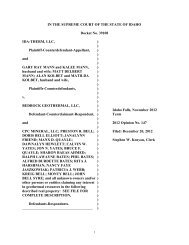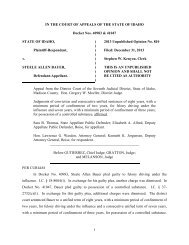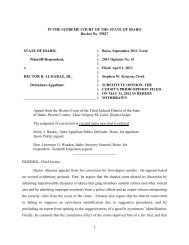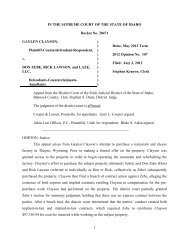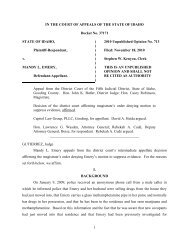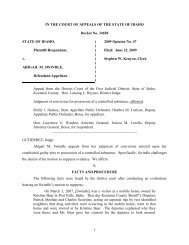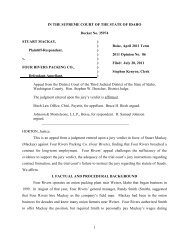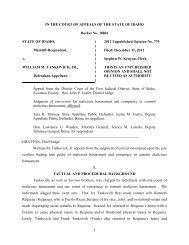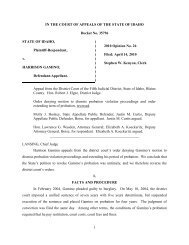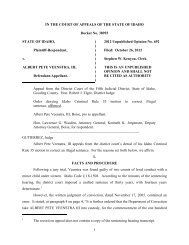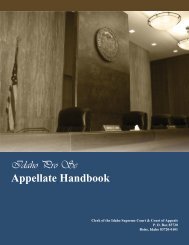Cramer v. Slater - Idaho State Judiciary
Cramer v. Slater - Idaho State Judiciary
Cramer v. Slater - Idaho State Judiciary
Create successful ePaper yourself
Turn your PDF publications into a flip-book with our unique Google optimized e-Paper software.
IN THE SUPREME COURT OF THE STATE OF IDAHO<br />
REBECCA CRAMER, individually and as<br />
surviving spouse of CURT E. CRAMER,<br />
v.<br />
Plaintiff-Appellant,<br />
Docket No. 34825<br />
CRISTIN SLATER, M.D.; IDAHO CENTER<br />
FOR REPRODUCTIVE MEDICINE, PC, an<br />
<strong>Idaho</strong> corporation; and K.C. CROWLEY,<br />
R.N.,<br />
and<br />
Defendants-Respondents,<br />
RUSSELL FOULK, M.D., JOEL SWANSON,<br />
M.D., INTERPATH LABORATORY, INC.,<br />
Defendants.<br />
)<br />
)<br />
)<br />
)<br />
)<br />
)<br />
)<br />
)<br />
)<br />
)<br />
)<br />
)<br />
)<br />
)<br />
)<br />
)<br />
)<br />
)<br />
)<br />
)<br />
)<br />
Boise, January 2009 Term<br />
2009 Opinion No. 38<br />
Filed: March 5, 2009<br />
Stephen W. Kenyon, Clerk<br />
Appeal from the Fourth Judicial District of the <strong>State</strong> of <strong>Idaho</strong>, Ada County. Hon.<br />
Michael R. McLaughlin, District Judge.<br />
The district court‟s grant of summary judgment in favor of ICRM, Dr. <strong>Slater</strong> and<br />
Nurse Crowley is reversed. The district court‟s denial of appellant‟s motion for a<br />
new trial is reversed. Judgment is vacated. This case is remanded for a new trial<br />
consistent with this Opinion.<br />
David E. Comstock and Byron V. Foster, Boise, for appellant. David Comstock<br />
argued.<br />
Hawley Troxell Ennis & Hawley, LLP, Boise, for respondent. Joseph D.<br />
McCollum, Jr. argued.<br />
W. JONES, Justice<br />
________________________________<br />
This appeal arises from an action filed by Rebecca <strong>Cramer</strong> (Rebecca) against Cristin<br />
<strong>Slater</strong>, M.D., <strong>Idaho</strong> Center for Reproductive Medicine, PC (ICRM), K.C. Crowley, R.N., Russell<br />
Foulk, M.D., Joel Swanson, M.D., Associated Regional and University Pathologists Laboratories<br />
1
(ARUP), and Interpath Laboratory, Inc. (Interpath) for the wrongful death of her husband, Curt<br />
<strong>Cramer</strong> (Curt), and the negligent infliction of severe mental and emotional distress.<br />
FACTUAL AND PROCEDURAL BACKGROUND<br />
In March of 2003, Rebecca and Curt employed Dr. <strong>Slater</strong>, Nurse Crowley and ICRM for<br />
the purpose of in vitro fertilization. Prior to the procedure, Curt tested positive for the Human<br />
Immunodeficiency Virus (HIV). Curt and Rebecca were both informed that they were HIV<br />
negative despite the fact that Curt tested positive for HIV. The <strong>Cramer</strong>s proceeded with the in<br />
vitro fertilization process, which ultimately failed. In March of 2004, Curt underwent a blood<br />
test in conjunction with obtaining a life insurance policy. The life insurance company informed<br />
Curt that he would need to see his regular physician for the results, and on April 12, 2004 Curt<br />
was informed by Dr. Swanson that he had tested HIV positive. Curt underwent a second HIV<br />
test at this appointment and was informed that negative test results are returned within a couple<br />
of days, but that positive test results would take longer to report. On April 15, 2004 Curt called<br />
Dr. Swanson regarding the second HIV test. At that point in time Dr. Swanson‟s office did not<br />
have a test result. Dr. Swanson‟s office has no record of the call; however, Curt‟s cellular<br />
telephone records indicate that a call was made. After the call, Curt failed to return to his home<br />
or to work. On April 17, 2004, Curt‟s body was found at the base of a cliff in Owyhee County.<br />
The cause of death was massive body trauma and the coroner‟s office classified it as a suicide.<br />
The classification of Curt‟s death was contested at trial, but the jury ultimately determined that<br />
Curt committed suicide.<br />
The district court granted summary judgment and dismissed the wrongful death claim<br />
against ICRM and Interpath. Dr. Foulk, ARUP, and Interpath were dismissed pursuant to a<br />
stipulation by the parties. The case proceeded to trial on the claim of negligent infliction of<br />
emotional distress asserted against Dr. Swanson, Dr. <strong>Slater</strong>, Nurse Crowley, and ICRM and on<br />
the allegation of wrongful death asserted against Dr. Swanson. The jury returned a verdict in<br />
favor of Rebecca on the claim of negligent infliction of emotional distress. The jury awarded<br />
$27,000 in economic damages and no non-economic damages. Rebecca appeals to this Court.<br />
Respondents request attorney‟s fees on appeal.<br />
ISSUES ON APPEAL<br />
The following issues are presented to this Court on appeal:<br />
2
1. Whether the district court erred by granting summary judgment in favor of ICRM on<br />
Rebecca‟s wrongful death claim.<br />
2. Whether the district court erred by admitting evidence of Curt‟s autopsy which<br />
showed the presence of amphetamines.<br />
3. Whether the district court erred by denying Rebecca‟s motion for a new trial.<br />
4. Whether the district court erred when it denied Rebecca‟s motion for costs pursuant<br />
to I.R.C.P. 54(d)(1)(C) and 54(d)(1)(D).<br />
5. Whether Respondents are entitled to attorney‟s fees on appeal pursuant to I.C. §§ 12-<br />
121, -120(3).<br />
STANDARD OF REVIEW<br />
This Court engages the same standard as the district court in evaluating an appeal from an<br />
order granting summary judgment. Baxter v. Craney, 135 <strong>Idaho</strong> 166, 170, 16 P.3d 263, 267<br />
(2000). “Summary judgment is appropriate if the pleadings, affidavits, and discovery documents<br />
on file with the court, read in a light most favorable to the nonmoving party, demonstrate no<br />
material issue of fact such that the moving party is entitled to a judgment as a matter of law.” Id.<br />
(citing I.R.C.P. 56(c)). “The burden of proving the absence of material facts is upon the moving<br />
party.” Id. “All disputed facts are to be construed liberally in favor of the nonmoving party, and<br />
all reasonable inferences that can be drawn from the record are to be drawn in favor of the<br />
nonmoving party.” Mackay v. Four Rivers Packing Co., 145 <strong>Idaho</strong> 408, 410, 179 P.3d 1064,<br />
1066 (2008). If reasonable people might reach a different conclusion from conflicting inferences<br />
based on the evidence then the motion must be denied. Id. “If the evidence is conflicting on<br />
material issues or supports conflicting inferences, or if reasonable minds could reach differing<br />
conclusions, summary judgment must be denied.” Doe v. Sisters of the Holy Cross, 126 <strong>Idaho</strong><br />
1036, 1039, 895 P.2d 1229, 1232 (Ct. App. 1995).<br />
This Court reviews evidentiary rulings from the trial court for an abuse of discretion.<br />
Burgess v. Salmon River Canal Co., Ltd., 127 <strong>Idaho</strong> 565, 574, 903 P.2d 730, 739 (1995). The<br />
trial court has the broad discretion to award costs and to grant or deny a motion for new trial.<br />
I.R.C.P. 54(d)(1)(B); Crowley v. Critchfield, 145 <strong>Idaho</strong> 509, 512, 181 P.3d 435, 438 (2007).<br />
When this Court examines a trial court‟s discretionary decision, it must be determined, “(1)<br />
whether the trial court correctly perceived the issue as one of discretion; (2) whether the trial<br />
court acted within the outer boundaries of its discretion and consistently with the legal standards<br />
3
applicable . . . ; and (3) whether the trial court reached its decision by an exercise of reason.”<br />
Burgess, 127 <strong>Idaho</strong> at 573, 903 P.2d at 738.<br />
“A cause of action for negligence includes proof of: (1) a duty, recognized by law,<br />
requiring the defendant to conform to a certain standard of conduct; (2) a breach of duty; (3) a<br />
causal connection between the defendant‟s conduct and the resulting injuries; and (4) actual loss<br />
or damage.” Coghlan v. Beta Theta Pi Fraternity, 133 <strong>Idaho</strong> 388, 399, 987 P.2d 300, 311<br />
(1999).<br />
ANALYSIS<br />
The district court erred by granting summary judgment in favor of ICRM on<br />
Rebecca’s wrongful death claim.<br />
ICRM filed for summary judgment on various grounds, including that ICRM did not<br />
proximately cause Curt‟s death. 1 Rebecca opposed the motion asserting that had Dr. <strong>Slater</strong><br />
properly informed Curt of his HIV positive status Curt would have received the proper medical<br />
and psychiatric care and would not have been subjected to the subsequent medical negligence of<br />
Dr. Swanson. The district court granted Rebecca‟s motion for summary judgment finding that<br />
ICRM had a duty to accurately report Curt‟s HIV positive status and that ICRM breached that<br />
duty. The district court found that genuine issues of material fact existed as to whether ICRM<br />
was the actual cause of Curt‟s death. 2 The district court held that no genuine issue of material<br />
fact existed as to whether ICRM was the proximate cause of Curt‟s death and granted summary<br />
judgment in favor of ICRM on the wrongful death claim. The district court alternatively held<br />
that Curt‟s suicide was a superseding act which prevents liability for any antecedent negligence<br />
committed by ICRM. 3 Rebecca appeals that decision to this Court. The issue of proximate<br />
cause and superseding cause will be addressed separately below.<br />
Prior to addressing the district court‟s grant of summary judgment, this Court will address<br />
the application of the Restatement (Second) of Torts § 457 (1965) in light of <strong>Idaho</strong>‟s<br />
comparative fault statute. In the present case, the district court noted that “as to an injured<br />
person, subsequent medical negligence is foreseeable. However, the [c]ourt finds the<br />
1<br />
Not all of the defendants conceded that Curt‟s death was a suicide, but for purposes of the summary judgment<br />
motion, the district court presumed that Curt‟s death was the result of a suicide.<br />
2<br />
The district court collectively referred to Nurse Crowley, Dr. <strong>Slater</strong> and ICRM as “ICRM.” This analysis will use<br />
the same language for this section only.<br />
3<br />
It is noted that the district court found that genuine issues of material fact existed as to whether Curt‟s suicide was<br />
a superseding act in regard to Dr. Swanson‟s alleged negligence.<br />
4
applicability of § 457 questionable in light of <strong>Idaho</strong>‟s adoption of comparative fault.” This Court<br />
has not specifically adopted the Restatement (Second) of Torts § 457 and we now determine that<br />
the Restatement (Second) of Torts § 457 and I.C. § 6-801 are not inconsistent and the two rules<br />
of law may co-exist in <strong>Idaho</strong>.<br />
Restatement (Second) of Torts § 457 states that “[i]f the negligent actor is liable for<br />
another‟s bodily injury, he is also subject to liability for any additional bodily harm resulting<br />
from normal efforts of third persons in rendering aid which the other‟s injury reasonably<br />
requires.” Restatement (Second) of Torts § 457 generally applies to any subsequent medical<br />
negligence which is necessary to correct an original act of medical negligence, thereby making<br />
acts of subsequent medical negligence generally foreseeable. It is assumed that the district court<br />
took issue with the comparative negligence statute, I.C. § 6-801, and the foreseeability of<br />
subsequent medical negligence because the Restatement (Second) of Torts § 457 imputes any<br />
subsequent liability to the original negligent actor rather than assigning to each actor a<br />
percentage of fault as required by the statute. However, because <strong>Idaho</strong> has adopted comparative<br />
fault, the Restatement (Second) of Torts § 457 operates as a general foreseeability rule for any<br />
subsequent medical negligence and does not impute liability arising from all subsequent<br />
negligent acts onto the original negligent actor. Any liability that is the result of subsequent<br />
medical negligence may be reduced by the percentage of fault attributable to each party. This<br />
does not affect foreseeability, but rather assigns the jury the task of distributing fault among all<br />
liable actors pursuant to I.C. § 6-801.<br />
It must also be determined whether Restatement (Second) of Torts § 457 is applicable in<br />
this instance because, as the district court noted, any alleged medical negligence committed by<br />
Dr. Swanson did not mitigate any bodily harm caused by ICRM. That is, Curt had no knowledge<br />
of his HIV positive status; therefore, he could not seek treatment from Dr. Swanson for any<br />
bodily harm caused by ICRM. Other jurisdictions have upheld use of the rule in instances where<br />
the injury complained about was the result of the failure to timely or properly diagnose a disease.<br />
That is, the rule has been used when the subsequent medical treatment was for a purpose other<br />
than the treatment of the physical injury. Daly v. U.S., 946 F.2d 1467 (9th Cir. 1991) (finding<br />
progression of the disease was foreseeable from the misdiagnosis despite similar negligent<br />
conduct from subsequent doctors); Deutsch v. Shein, 597 S.W.2d 141 (Ky. 1980) (finding that<br />
subsequent negligent medical advice to obtain an abortion was foreseeable for failing to diagnose<br />
5
a pregnancy and administrating x-rays thereby exposing the fetus to radiation); Lindquist v.<br />
Dengel, 595 P.2d 934 (Wa. 1979) (finding that the failure to diagnose tuberculosis could<br />
foreseeably lead to the unnecessary, and potentially negligent, removal of part of the lung);<br />
Davidson v. Gaillard, 584 So.2d 71 (Fla. Dist. Ct. App. 1991) (failure to diagnose reoccurring<br />
lymphoma could foreseeably result in subsequent medical negligence and cause the death of the<br />
patient); Amu v. Barnes, 650 S.E.2d 288 (Ga. Ct. App. 2007) (finding that the failure to diagnose<br />
colon cancer from complaints of rectal bleeding could foreseeably lead to progression of the<br />
disease despite subsequent medical negligence for failure to administer a colonoscopy); Walker<br />
v. Giles, 624 S.E.2d 191 (Ga. Ct. App. 2005) (failing to diagnose a pregnant woman‟s<br />
appendicitis could foreseeably lead to further negligent misdiagnosis and treatment which results<br />
in miscarriage, stroke and paralysis). Similarly, Rebecca‟s complaint alleged that the injury, her<br />
emotional distress and Curt‟s suicide, were the result of ICRM‟s failure to properly and timely<br />
diagnose and treat Curt. The district court incorrectly found that the Restatement (Second) of<br />
Torts § 457 does not apply in <strong>Idaho</strong> and does not apply in this case.<br />
Ultimately, the court held that “Curt‟s suicide and the manner of its occurrence [are] so<br />
highly unusual that as a matter of law no reasonable person would expect the suicide to occur as<br />
a result of the alleged misconduct of the ICRM Defendants in this case.” This Court reverses<br />
that decision and finds summary judgment inapplicable in the present case because genuine<br />
issues of material fact exist as to whether Curt‟s death was proximately caused by ICRM‟s<br />
negligence and whether Curt‟s suicide was a supervening act.<br />
Genuine issues of material fact exist as to whether Curt’s death was proximately<br />
caused by ICRM’s negligence.<br />
Proximate cause consists of actual cause and true proximate cause, which is also referred<br />
to as legal cause. Newberry v. Martens, 142 <strong>Idaho</strong> 284, 288, 127 P.3d 187, 191 (2005). In other<br />
words, proximate cause “is composed of two elements: cause in fact and scope of legal<br />
responsibility.” Sisters of the Holy Cross, 126 <strong>Idaho</strong> at 1039, 895 P.2d at 1232. “Actual cause is<br />
the factual question of whether a particular event produced a particular consequence.”<br />
Newberry, 142 <strong>Idaho</strong> at 288, 127 P.3d at 191. But true proximate cause focuses on whether legal<br />
policy supports responsibility being “extended to the consequences of conduct. . . . [it]<br />
determines whether liability for that conduct attaches.” Id. (internal citations omitted) (quoting<br />
Henderson v. Cominco American, Inc., 95 <strong>Idaho</strong> 690, 695, 518 P.2d 873, 878 (1973)). That is,<br />
6
“whether it was reasonably foreseeable that such harm would flow from the negligent conduct.”<br />
Sisters of the Holy Cross, 126 <strong>Idaho</strong> at 1040, 895 P.2d at 1233. This Court must decide whether<br />
the injury and manner of the occurrence are “so highly unusual that we can say, as a matter of<br />
law that a reasonable [person], making an inventory of the possibilities of harm which his<br />
conduct might produce, would not have reasonably expected the injury to occur.” Id. at 1041,<br />
895 P.2d at 1234 (internal quotations and citations omitted) (quoting Alegria v. Payonk, 101<br />
<strong>Idaho</strong> 617, 619-20, 619 P.2d 135, 137-38 (1980)). The question of proximate cause is one of fact<br />
and almost always for the jury. Id. at 1041, 895 P.2d at 1234. “[P]roximate cause is one of fact<br />
to be submitted to the jury and not a question of law for the court; if, upon all the facts and<br />
circumstances, there is a reasonable chance or likelihood of the conclusions of reasonable<br />
[people] differing, the question is one for the jury.” Id. (quoting Alegria, 101 <strong>Idaho</strong> at 619-20,<br />
619 P.2d at 137-38).<br />
This Court finds that genuine issues of material fact exist as to whether ICRM‟s<br />
negligence proximately caused Curt‟s suicide. Rebecca produced affidavits at the summary<br />
judgment phase which stated that suicidal ideations are reasonably foreseeable after a person is<br />
informed of their HIV positive status. It was this evidence that precluded summary judgment in<br />
favor of Dr. Swanson on the issue of whether his alleged negligence proximately caused Curt‟s<br />
death. In accordance with Restatement (Second) of Torts § 457, subsequent medical negligence<br />
is generally foreseeable, including instances where the injury complained of stems from an<br />
original negligent act failing to properly diagnose and treat. However, the district court‟s<br />
conclusion that no genuine issue of material fact existed was based on Rebecca‟s failure to<br />
produce any testimony as to whether a person would have suicidal ideations by being informed<br />
that s/he is HIV negative. Although this analysis is valid, it leaps over a few factual issues which<br />
create genuine issues of material fact. Rebecca‟s primary contention is that by negligently<br />
misinforming Curt that he is HIV negative and thereby not providing him with counseling and<br />
treatment, ICRM leaves open the possibility that Curt would later be negligently informed of his<br />
correct HIV status. Dr. Swanson‟s subsequent medical negligence 4 is foreseeable in accordance<br />
with the Restatement (Second) of Torts § 457. Therefore, this Court cannot say, as a matter of<br />
law, that Curt‟s suicidal ideations were unforeseeable when he was negligently misinformed by<br />
4 It is assumed, for purposes of this analysis at the summary judgment phase, that Dr. Swanson‟s conduct constituted<br />
medical negligence.<br />
7
ICRM that he was HIV negative and subsequently subjected to the medical negligence of Dr.<br />
Swanson.<br />
Further, the district court failed to note the possibility that if a person is informed that<br />
s/he is HIV negative and subsequently informed that s/he is HIV positive that the person may<br />
conclude that s/he contracted HIV within the interim. The district court‟s analysis fails to take<br />
into account the incurable nature of HIV; an HIV positive person will eventually be informed<br />
that s/he is HIV positive. HIV is contracted through the transfer of bodily fluids and most<br />
commonly associated with unprotected sexual activity and intravenous drug use. In fact, Dr.<br />
Swanson‟s notes reflect that this information was indeed given to Curt when he was informed of<br />
his HIV positive status.<br />
[I] [d]iscussed with [Curt] [the] risk factors for HIV. He has been married for<br />
four years. He strongly states he has had no other sexual encounters following his<br />
marriage other than his wife and he feels his wife is the same. Just six months<br />
ago his wife underwent in vitro fertilization and he stated he underwent an<br />
“infectious disease testing” and at that time [he] was negative. He denies any<br />
other high risk factors including IV drug abuse and any recent blood transfusions<br />
are distant. Again, [Curt has engaged in] no sexual improprieties since prior to<br />
being married.<br />
(Emphasis added). This information, in and of itself, could reasonably lead a person to believe<br />
that the cause of the HIV is sexual impropriety; if Curt knew he had not engaged in any sexual<br />
encounters outside of the marriage only one logical conclusion remains. Reasonable minds<br />
could differ as to whether ICRM‟s negligence for the failure to correctly inform Curt that he was<br />
HIV positive could lead to his subsequent suicide. If a person is HIV positive s/he will retain<br />
that status for the foreseeable future. That is, if a person is negligently misinformed that s/he is<br />
HIV negative it is foreseeable that the person will eventually be correctly informed that s/he is<br />
HIV positive, so the question becomes whether it is foreseeable that the HIV positive person will<br />
have suicidal ideations when s/he is correctly informed and this is precisely the evidence<br />
Rebecca produced at the summary judgment phase. Merely analyzing the issue as to whether a<br />
person will have suicidal ideation when informed s/he is HIV negative fails to take into account<br />
any future conduct of other actors and the fact that the person will eventually be informed s/he is<br />
HIV positive.<br />
The district court correctly found that ICRM had a duty to inform Curt of his HIV<br />
positive status and that ICRM breached that duty. Further, ICRM negligently failed to<br />
8
ecommend Curt to counseling and treatment for the disease, which would have reduced or<br />
eliminated any subsequent negligence by Dr. Swanson. ICRM was in a position to prevent the<br />
ultimate result in this case by properly diagnosing and treating Curt; ICRM breached its duty to<br />
Curt and should not be relieved of its responsibility for that breach merely because Dr. Swanson<br />
subsequently engaged in foreseeable negligent conduct. In accordance with Restatement<br />
(Second) of Torts § 457, subsequent medical negligence is generally foreseeable. Although<br />
ICRM‟s potential liability will be reduced by a determination of any comparative negligence of<br />
Dr. Swanson pursuant to I.C. § 6-801, the comparative negligence statute does not reduce the<br />
foreseeability of Curt‟s injury; it merely reduces the liability of ICRM if the jury determines that<br />
Curt‟s death was proximately caused by ICRM‟s breach. Whether ICRM‟s actions proximately<br />
caused Curt‟s death is a question of fact for the jury. This Court reverses the district court‟s<br />
grant of summary judgment in favor of ICRM and holds that questions of fact exist as to whether<br />
ICRM proximately caused Curt‟s death.<br />
act.<br />
Genuine issues of material fact exist as to whether Curt’s suicide was a superseding<br />
Respondents argue that the district court correctly ruled that Curt‟s suicide was a<br />
superseding event with regard to ICRM‟s negligence. This Court has adopted the Restatement<br />
(Second) of Torts § 440 (1965). Mico Mobile Sales and Leasing, Inc. v. Skyline Corp., 97 <strong>Idaho</strong><br />
408, 411, 546 P. 2d 54, 57 (1975). “A superseding cause is an act of a third person or other force<br />
which by its intervention prevents the actor from being liable for harm to another which his<br />
antecedent negligence is a substantial factor in bringing about.” Id. at 411-12, 546 P. 2d at 57-<br />
58. (quoting Lundy v. Hazen, 90 <strong>Idaho</strong> 323, 329, 411 P.2d 768, 771 (1966)). The following<br />
guidelines are used to determine whether an intervening act is a superseding cause:<br />
(a) the fact that its intervention brings about harm different in kind from that<br />
which would otherwise have resulted from the actor‟s negligence;<br />
(b) the fact that its operation or the consequences thereof appear after the event to<br />
be extraordinary rather than normal in view of the circumstances existing at the<br />
time of its operation;<br />
(c) the fact that the intervening force is operating independently of any situation<br />
created by the actor‟s negligence, or, on the other hand is or is not a normal result<br />
of such a situation;<br />
(d) the fact that the operation of the intervening force is due to a third person‟s act<br />
or to his failure to act;<br />
(e) the fact that the intervening force is due to an act of a third person which is<br />
wrongful toward the other and as such subjects the third person to liability to him;<br />
9
(f) the degree of culpability of a wrongful act of a third person which sets the<br />
intervening force in motion.<br />
Id. at 412, 546 P.2d at 58 (quoting Restatement (Second) of Torts, § 442 (1965)).<br />
Both parties cite to Brooks v. Logan, for a determination of whether Curt‟s suicide<br />
constitutes a superseding cause. That case stemmed from the suicide of a high school student<br />
and a subsequent cause of action filed by the student‟s parents against the teacher and the school<br />
district for their failure to intervene in the student‟s contemplated suicide. Brooks v. Logan, 127<br />
<strong>Idaho</strong> 484, 486, 903 P.2d 73, 75 (1995). This Court held that the doctrine of superseding cause<br />
is “inapplicable to both the wrongful death action[] and the [parents‟] cause of action for<br />
negligent infliction of emotional distress. . . . [W]e believe the question is more appropriately<br />
one of comparative negligence. . . . It is for the jury to compare the negligence of all the actors.”<br />
Id. at 491-92, 903 P.2d at 80-81 (internal citation omitted). The Court cited to <strong>Idaho</strong>‟s<br />
comparative negligence statute which states that “[c]ontributory negligence or comparative<br />
responsibility shall not bar recovery in an action by any person . . . to recover damages . . .<br />
resulting in death or injury to [a] person” unless that person‟s own negligence was greater than<br />
the negligence “of the person against whom recovery is sought.” I.C. § 6-801. In Brooks, this<br />
Court ultimately held that the issue of the comparative negligence which resulted in the student‟s<br />
suicide was not a determination to be made on summary judgment. Brooks, 127 <strong>Idaho</strong> at 492,<br />
903 P.2d at 81.<br />
In the present case, the district court found “that when a psychiatrist, psychologist, or<br />
doctor fails to properly assess a patient‟s suicidal ideations and consequently fails to take steps to<br />
prevent the suicide, these professionals can be held liable for the patient‟s suicide.” (Citing 81<br />
A.L.R. 5 th 167 § 6[a] (2000)). This analysis is supported by the Court‟s decision in Brooks.<br />
Curt‟s suicide is the injury that Rebecca‟s complaint alleges. Therefore, similar to Brooks,<br />
questions of fact exist as to whether a duty exists to prevent that injury. It necessarily follows<br />
that if a doctor has a duty to accurately assess a patient‟s suicidal ideations and Rebecca<br />
submitted evidence that suicidal ideations are foreseeable if a patient is informed of his/her HIV<br />
positive status then the analysis would be one of comparative negligence among all the actors.<br />
Again, ICRM failed to follow through with the required treatment of an HIV positive patient<br />
which would have eliminated Dr. Swanson‟s negligence. Similar to the analysis in Brooks, this<br />
case is more closely akin to a question of comparative negligence as between Curt, Dr. <strong>Slater</strong>,<br />
10
ICRM, Nurse Crowley, Dr. Foulk, Dr. Swanson, ARUP and Interpath. 5 All the actors<br />
contributed to some degree, and the jury is charged with the factual determination of which<br />
actors will be held liable. Rebecca is asserting that Curt‟s suicide was the foreseeable<br />
consequence of all the parties‟ alleged negligence. This issue would have been properly left for<br />
the jury. This Court finds summary judgment inappropriate in favor of ICRM.<br />
The district court did not err by admitting evidence of Curt <strong>Cramer</strong>’s autopsy<br />
which showed the presence of amphetamines.<br />
“Trial courts have broad discretion when ruling on a motion in limine so we review the<br />
district court‟s decision to grant or deny a motion in limine for abuse of discretion.” Puckett v.<br />
Verska, 144 <strong>Idaho</strong> 161, 167, 158 P.3d 937, 943 (2007). “The Court reviews trial court decisions<br />
admitting or excluding evidence . . . under the abuse of discretion standard.” Morris v.<br />
Thomson, 130 <strong>Idaho</strong> 138, 144, 937 P.2d 1212, 1218 (1997). An incorrect ruling only warrants a<br />
new trial if the error affected a substantial right of a party. Id. (citing I.R.C.P. 61; I.R.E. 103).<br />
Rebecca contends that it was error for the trial court to deny her motion in limine to<br />
exclude a toxicology report which indicates evidence of amphetamines in Curt‟s urine. Plaintiff<br />
asserts that the report improperly ignited passion and prejudice in the jury because amphetamines<br />
and methamphetamines are indistinguishable to lay persons. The trial court allowed the<br />
toxicology report to be admitted for the factual purpose of determining Curt‟s cause of death<br />
which was a disputed issue. The court found it relevant to the issue of whether Curt‟s death was<br />
accidental or a suicide.<br />
In the district court‟s decision the judge recognized the decision as discretionary. The<br />
trial court found that the report was relevant because “Curt‟s mental status and whether or not he<br />
was impaired by drugs at the time of his death is directly relevant to establishing other factors<br />
that lead to Curt potentially taking his own life or if this was an accidental death.” The trial court<br />
further noted that Rebecca would be able to present evidence that the toxicology report had no<br />
confirmatory test and, therefore, may be inaccurate or questionable. Ultimately, the court found<br />
the evidence relevant in light of the circumstances surrounding Curt‟s death and ruled the<br />
toxicology report admissible. In fact, Rebecca presented expert testimony at trial which<br />
indicated that amphetamines may be present from the use of prescription and over-the-counter<br />
asthma medication and that Curt had taken medicine in conjunction with his asthma. This Court<br />
5 All parties still remained in the action at the summary judgment stage.<br />
11
finds that the trial court did not abuse its discretion in denying the motion in limine to exclude<br />
the toxicology report. Even assuming that admission of the toxicology report constituted error,<br />
any error would have been mitigated by expert testimony, and therefore, would constitute<br />
harmless error. White v. Mock, 140 <strong>Idaho</strong> 882, 891, 104 P.3d 356, 365 (2004) (“A judgment may<br />
not be disturbed on appeal due to error in an evidentiary ruling unless the error affected the<br />
substantial rights of a party.”)<br />
The district court erred by denying Rebecca’s motion for a new trial.<br />
Rebecca argued to the district court that she was entitled to a new trial pursuant to<br />
I.R.C.P. 59(a) because of irregularities in the Special Verdict, the jury‟s failure to award<br />
emotional distress damages, and the district court‟s denial of her motion in limine. The issue of<br />
irregularities in the jury verdict was properly raised before the jury was discharged. Crowley,<br />
145 <strong>Idaho</strong> at 512, 181 P.3d at 438 (stating that “[t]he time for challenging a verdict as<br />
inconsistent is when it is returned.”) Rebecca pursues the same arguments on appeal. This Court<br />
will not address any alleged error in the denial of the motion in limine because it is discussed<br />
above. Due to inconsistencies in the verdict form, this Court reverses the district court‟s denial<br />
of Rebecca‟s motion for a new trial.<br />
“A new trial may be granted to all or any of the parties and on all or part of the issues in<br />
an action for . . . [i]rregularities in the proceedings . . . [or] [e]rror in law.” I.R.C.P. 59(a)(1),<br />
59(a)(7). This Court reviews the grant or denial of a motion for new trial for an abuse of<br />
discretion. Puckett, 144 <strong>Idaho</strong> at 168, 158 P.3d at 944. “[A] jury verdict on issues of negligence<br />
and causation will not be disturbed on appeal unless it appears to the reviewing court that the<br />
verdict is either not supported by substantial competent evidence or is against the clear weight of<br />
the evidence.” Burgess, 127 <strong>Idaho</strong> at 570, 903 P.2d at 735. Generally, this Court will not disturb<br />
a jury‟s factual determinations on appeal. Hei v. Holzer, 145 <strong>Idaho</strong> 563, 566, 181 P.3d 489, 492<br />
(2008).<br />
It is axiomatic that a factual determination made by a jury will not be overturned<br />
if it is sustained by the evidence. This is particularly true in tort actions where the<br />
damages cannot be ascertained with mathematical precision. Hence, where such<br />
injuries are subjective and measurable with only an approximation of certainty,<br />
their award is primarily a question for the jury and an appellate court should<br />
interfere with such a verdict only in the most exceptional circumstances.<br />
12
Id. at 566-67, 181 P.3d at 492-93 (quoting Bentzinger v. McMurtrey, 100 <strong>Idaho</strong> 273, 274, 596,<br />
P.2d 785, 786 (1979)). The plaintiff bears the burden of proving every element in a negligence<br />
action, including damages. Id. at 567, 181 P.3d at 493. “The issue of damages is a factual<br />
question.” Id.<br />
The Special Verdict form answered the following relevant questions 6 :<br />
(1) [Proximate cause of Interpath].<br />
(2) Do you find that K.C. Crowley, R.N. breached the standard of health care practice?<br />
[YES]<br />
(3) Do you find that Christin [sic] <strong>Slater</strong>, M.D. breached the standard of health care<br />
practice? [YES]<br />
(4) Do you find that the negligence of ICRM was a proximate cause of the Plaintiff‟s<br />
emotional distress as outlined in Instruction No. 33? 7 [NO]<br />
(5) If you answered some of the questions “Yes”, then set forth the percentage of<br />
negligence as to any Defendant that you answered “Yes” in Question No. 1 through<br />
Question No. 4. If you answered “No” as to a Defendant, leave the percentage (%)<br />
blank or place a N/A (Not Applicable) in the blank. Considering all of the negligence<br />
which proximately caused the Plaintiff‟s emotional distress, we find the negligence<br />
causing the Plaintiff‟s emotional distress in the following percentages:<br />
a. Defendant Interpath N/A%<br />
b. Defendant ICRM N/A%<br />
c. Defendant K.C. Crowley, R.N. 40%<br />
d. Defendant Christian [sic] <strong>Slater</strong>, M.D. 60%<br />
Total must equal 100%<br />
(6) What is the amount of damages sustained by the Plaintiff on her claims as to<br />
Interpath, ICRM, Dr. <strong>Slater</strong> and Nurse Crowley?<br />
a. Non-Economic Damages: $0<br />
b. Economic Damages: $27,000<br />
(7) Was Curt <strong>Cramer</strong>‟s death a suicide? [YES]<br />
(8) [Negligence of Dr. Swanson for wrongful death claim]<br />
(9) [Proximate cause of Dr. Swanson for wrongful death claim]<br />
(10) [Percentage of fault between Dr. Swanson and Curt for wrongful death claim]<br />
(11) [Damages against Dr. Swanson for wrongful death claim]<br />
(12) [Negligence and proximate cause of Dr. Swanson for emotional distress claim]<br />
(13) [Damages against Dr. Swanson for emotional distress claim]<br />
(14) Was the negligence of ICRM reckless as defined to you in Instruction No. 31? [YES]<br />
(15) [Recklessness of Interpath]<br />
(16) [Recklessness of Dr. Swanson]<br />
(17) Was the negligence of the Defendant Dr. <strong>Slater</strong> reckless as defined to you in<br />
Instruction No. 31? [NO]<br />
6 Only the alleged inconsistencies from the special verdict form are quoted. However, the subject matter of the<br />
omitted questions is mentioned to keep the numbering consistent and for the ease of the reader. Only the questions<br />
completely irrelevant to this appeal have been omitted.<br />
7 The jury instructions do not appear in the record or transcript on appeal.<br />
13
(18) Was the negligence of the Defendant Nurse Crowley reckless as defined to you in<br />
Instruction No. 31? [NO]<br />
Both parties cite to Instructions No. 21 and 22 which appear in the record as an attachment to an<br />
affidavit supporting the motion for new trial, however, the jury instructions do not otherwise<br />
appear in the record or transcript on appeal. 8 Accordingly, this Court denies review of the<br />
instructions as a whole and the issue of whether the jury was properly instructed. Without the<br />
jury instructions this Court is unable to make a determination of whether the jury was properly<br />
instructed.<br />
The Special Verdict form is unmistakably confusing. The district court found the jury‟s<br />
Special Verdict form was reconcilable. The court rationalized that the jury found Dr. <strong>Slater</strong> and<br />
Nurse Crowley negligent, but did not find ICRM vicariously liable for their negligence.<br />
However, according to instruction Nos. 21 and 22 the jury did not have a choice of whether to<br />
find ICRM vicariously liable. Respondents argue that the verdict is reconcilable by arguing that<br />
the jury found Dr. <strong>Slater</strong> and Nurse Crowley negligent and ICRM stipulated to their negligence;<br />
therefore, the only issue which pertained to ICRM was whether ICRM proximately caused the<br />
emotional distress experienced by Rebecca. The jury found that ICRM did not proximately<br />
cause Rebecca‟s injury. However, this fails to take into account any liability of ICRM based on<br />
vicarious liability for the negligence of Dr. <strong>Slater</strong> and Nurse Crowley. In essence, from<br />
questions 2, 3 and 5 it can be inferred that the jury found Dr. <strong>Slater</strong> and Nurse Crowley were<br />
negligent and proximately caused the injury. However, they also found that ICRM‟s negligence<br />
did not proximately cause the injury after being instructed that any negligence on the part of Dr.<br />
<strong>Slater</strong> or Nurse Crowley would be imputed to ICRM. This Court may determine that the jury<br />
verdict is reconcilable by interpreting the verdict to hold ICRM vicariously liable for Dr. <strong>Slater</strong><br />
and Nurse Crowley‟s negligence, but that the jury did not find ICRM‟s actions in and of<br />
themselves were the proximate cause of Rebecca‟s emotional distress. That is, ICRM is liable<br />
for the percentage of fault attributable to each of the actors that it is vicariously liable for, Nurse<br />
8 Instruction No. 21 reads:<br />
K.C. Crowley, R.N., involved in the care of Curt <strong>Cramer</strong> was an employee of ICRM at the time of<br />
the occurrence. Therefore, you are instructed any act or omission of K.C. Crowley, R.N., in her<br />
care of Curt <strong>Cramer</strong> was the act or omission of Defendant ICRM.<br />
Instruction No. 22 reads:<br />
Cristin <strong>Slater</strong>, M.D., who was involved in the care of Curt <strong>Cramer</strong> was an employee of ICRM at<br />
the time of the occurrence. Therefore, you are instructed any act or omission of Cristin <strong>Slater</strong>,<br />
M.D. in her care of Curt <strong>Cramer</strong> was the act or omission of the Defendant ICRM.<br />
14
Crowley and Dr. <strong>Slater</strong>, but ICRM does not have any liability for its own individual actions,<br />
though that conclusion ignores that ICRM can only act through its employees. This Court finds<br />
that the jury‟s verdict is inconsistent and beyond reasonable reconciliation. The jury contradicts<br />
itself throughout the findings. Rebecca properly objected when the verdict was returned and<br />
asked the court to have the jury reconcile the verdict. The court declined to do so and this Court<br />
cannot reasonably reconcile the verdict. This Court reverses the judgment and grants Rebecca‟s<br />
motion for a new trial.<br />
Rebecca contends that the jury erroneously failed to grant non-economic damages on her<br />
claim for emotional distress. She states that her emotional distress was uncontested at trial and<br />
reiterates the trauma she experienced as a result of the in vitro fertilization procedures and Curt‟s<br />
suicide. The jury‟s award of only economic damages is curious, troubling and potentially<br />
inconsistent. We cannot make a ruling on any matter regarding the jury instructions because the<br />
jury instructions are not contained in the record. Although it is permissible for a jury to find that<br />
the Plaintiff failed to meet the burden of proving non-economic damages, it is curious how a jury<br />
could find negligent infliction of emotional distress and then not compensate Rebecca for any of<br />
the emotional distress she suffered. A showing of emotional distress does not necessitate a<br />
finding of non-economic damages. As stated in Hei, damages in a tort claim cannot be<br />
“ascertained with mathematical precision.” Hei, 145 <strong>Idaho</strong> at 566-67, 181 P.3d at 492-93<br />
(quoting Bentzinger, 100 <strong>Idaho</strong> at 274, 596, P.2d at 786). However, unlike in Hei, Rebecca‟s<br />
emotional distress and any non-economic damages stemming from the emotional distress were<br />
uncontested. In Hei there was testimony which supported a finding that her emotional distress<br />
could have been the result of several other factors. Id. at 568, 181 P.3d at 494 (finding one of the<br />
factors supporting the jury verdict was that conflicting expert testimony existed to support<br />
varying degrees and the root of Hei‟s psychological trauma).<br />
This Court holds that the inconsistencies in the verdict form and the jury‟s findings are<br />
irreconcilable and the motion for a new trial should have been granted. This Court need not<br />
address whether it was error to deny the new trial for any alleged error in admitting the<br />
toxicology report because that issue has been previously addressed.<br />
Whether the district court erred when it denied Rebecca’s motion for costs pursuant<br />
to I.R.C.P. 54(d)(1)(C) and 54(d)(1)(D).<br />
15
Rebecca petitioned the court for an award of costs as a matter of right in the amount of<br />
$12,505.91 and discretionary costs in the amount of $35,827.34. The trial court awarded<br />
$2,445.83 as a matter of right and declined to award discretionary costs.<br />
This Court will not address this issue because the case is remanded for a new trial. Upon<br />
retrial it is within the discretion of the district court to determine who the prevailing party is on<br />
which claims and whether that party is entitled to costs.<br />
120(3), -121.<br />
Respondents are not entitled to attorney’s fees on appeal pursuant to I.C. §§ 12-<br />
Respondents make a claim for attorney‟s fees pursuant to I.C. §§ 12-120(3), -121. “I.C. §<br />
12-120(3) . . . allows recovery for attorney fees by the prevailing party in any commercial<br />
transaction.” Mackay, 145 <strong>Idaho</strong> at 415, 179 P.3d at 1071. A “commercial transaction” is<br />
defined as any transaction, except transactions for personal household purposes. I.C. § 12-<br />
120(3). I.C. § 12-121 “provides that „[i]n any civil action, the judge may award reasonable<br />
attorney‟s fees to the prevailing party. . . .‟ Such an award is appropriate when this Court has the<br />
abiding belief that the appeal was brought or defended frivolously, unreasonably or without<br />
foundation.” BHA Investments, Inc. v. <strong>State</strong>, 138 <strong>Idaho</strong> 348, 355, 63 P.3d 474, 481 (2003)<br />
(citing I.C. § 12-121).<br />
Respondents are not the prevailing party in this action; therefore, there is no entitlement<br />
to attorney‟s fees under either statute. Moreover, this case does not constitute a commercial<br />
transaction; therefore I.C. § 12-120(3) is inapplicable to the present action.<br />
CONCLUSION<br />
For the foregoing reasons this Court reverses the district court‟s grant of summary<br />
judgment in favor of ICRM, Dr. <strong>Slater</strong> and Nurse Crowley. Further, this Court reverses the<br />
denial of Rebecca‟s motion for a new trial; the judgment is vacated and this case is remanded for<br />
a new trial consistent with this opinion.<br />
Justices BRUDICK, J. JONES, HORTON and Justice Pro Tem KIDWELL, CONCUR<br />
16



